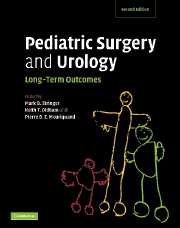Book contents
- Frontmatter
- Contents
- List of contributors
- Acknowledgments
- Preface
- Part I General issues
- Part II Head and neck
- Part III Thorax
- Part IV Abdomen
- Part V Urology
- 41 Introduction
- 42 Upper tract dilation
- 43 Posterior urethral valves
- 44 Vesicoureteric reflux
- 45 Genitoplasty in exstrophy and epispadias
- 46 Feminization (surgical aspects)
- 47 Hypospadias
- 48 Bladder exstrophy
- 49 Surgery for neuropathic bladder and incontinence
- 50 Non-neuropathic bladder–sphincter dysfunction
- 51 Undescended testes
- 52 Circumcision
- 53 The single kidney
- 54 Multicystic kidney
- 55 Urolithiasis
- 56 Gonadal tumors
- Part VI Oncology
- Part VII Transplantation
- Part VIII Trauma
- Part IX Miscellaneous
- Index
- Plate section
- References
49 - Surgery for neuropathic bladder and incontinence
from Part V - Urology
Published online by Cambridge University Press: 08 January 2010
- Frontmatter
- Contents
- List of contributors
- Acknowledgments
- Preface
- Part I General issues
- Part II Head and neck
- Part III Thorax
- Part IV Abdomen
- Part V Urology
- 41 Introduction
- 42 Upper tract dilation
- 43 Posterior urethral valves
- 44 Vesicoureteric reflux
- 45 Genitoplasty in exstrophy and epispadias
- 46 Feminization (surgical aspects)
- 47 Hypospadias
- 48 Bladder exstrophy
- 49 Surgery for neuropathic bladder and incontinence
- 50 Non-neuropathic bladder–sphincter dysfunction
- 51 Undescended testes
- 52 Circumcision
- 53 The single kidney
- 54 Multicystic kidney
- 55 Urolithiasis
- 56 Gonadal tumors
- Part VI Oncology
- Part VII Transplantation
- Part VIII Trauma
- Part IX Miscellaneous
- Index
- Plate section
- References
Summary
Introduction
Children with a neuropathic bladder may have bladder characteristics ranging from a high pressure non-compliant small capacity bladder with a high outlet resistance (unsafe), on the one hand, to a compliant low pressure capacious bladder with low outflow resistance (safe), on the other. Most children will demonstrate a mixed picture, and bladder and outflow characteristics may change with time thereby necessitating regular surveillance.
The aims of management of these children are:(i) preservation of renal function (ii) attaining urinary continence and therefore (iii) enabling social integration and improvement in quality of life. These aims can be achieved with a container (reservoir), which is capacious and low pressure, adequate outflow resistance (bladder neck and sphincter muscle complex) and a conduit to keep the reservoir empty at regular intervals (urethra, Mitrofanoff conduit).
This chapter concentrates on the long-term outcomes of the various treatment options that have been used and will not describe the technical aspects for which the reader is referred to several excellent texts on the subject.
The treatment modalities described include non-surgical (CIC and pharmacotherapy) surgery of the outlet (bladder-neck procedures, minimally invasive procedures and sphincters), surgery of the reservoir (augmentation cystoplasty), continent catheterizable conduits (Mitrofanoff principle), and urinary diversion (vesicostomy, refluxing ureterostomy, and ileal conduit).
- Type
- Chapter
- Information
- Pediatric Surgery and UrologyLong-Term Outcomes, pp. 631 - 642Publisher: Cambridge University PressPrint publication year: 2006
References
- 2
- Cited by

